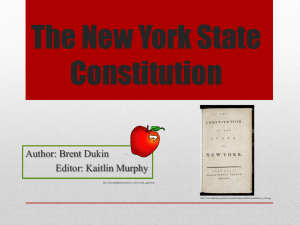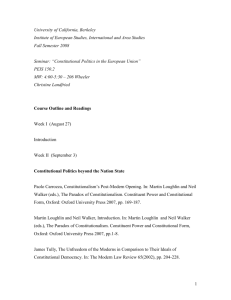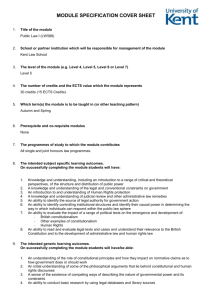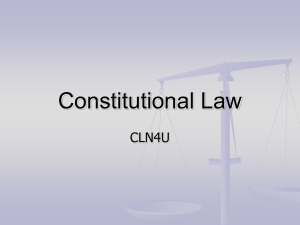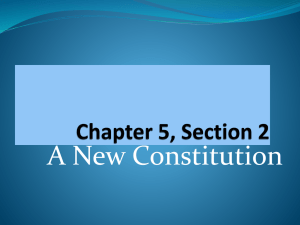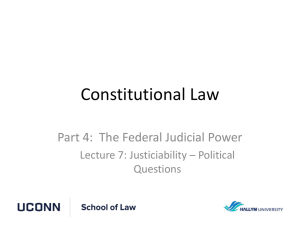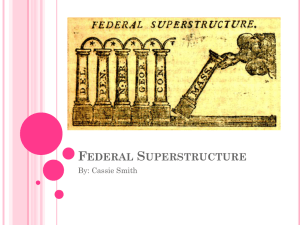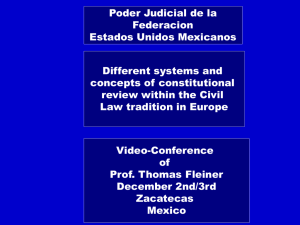constitutional - halmaigabor.hu
advertisement
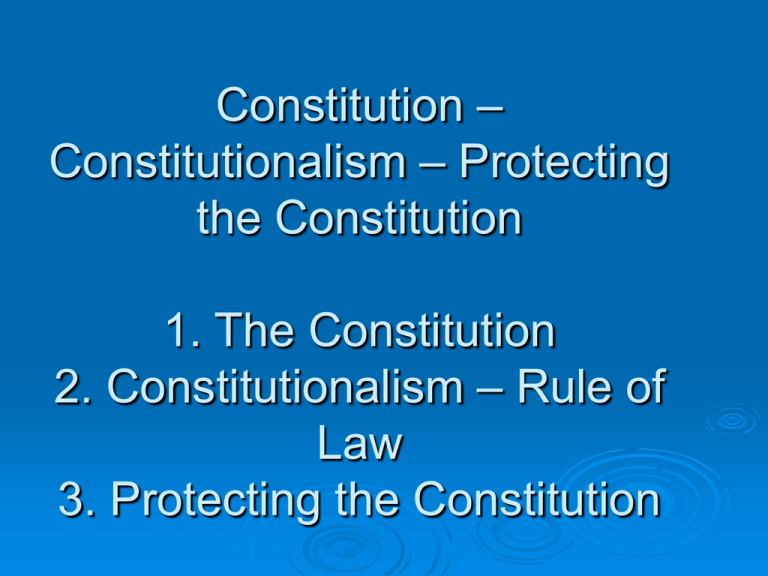
Constitution – Constitutionalism – Protecting the Constitution 1. The Constitution 2. Constitutionalism – Rule of Law 3. Protecting the Constitution 1. The Constitution describing the terms of power; the fears deriving from the previous regimes (András Sajó: Limiting Government); the moral sail of the state (Ronald Dworkin) in dictatorships: only a paper the notion of constitution in material sense: the position of the state and its citizens – in this sense every state has a constitution in formal sense: one single written document, the basic law (no constitution: UK, Israel, Saudi Arabia) historical background: the ‘politea’ of Aristotle – the governance of a city state, the form of government Cicero’s ‘constitutio’ – the basic norms of a community the contract theory: the original source of the power is the contract between the people and the ruler (Ulpianus) – breach of contract ~ right to resistance, killing the oppressor (Magna Charta, Golden Bull; Thomas Acquinas) the modern constitution – the first form of the modern state: absolute monarchy in the 17th century → concentration of power → puritan revolution → constitutional monarchy ~ constitutional government the development of the American and French constitutionalism in the 18th century the legal character of the constitution: supremacy and its protection by complicated amendment procedures – dissolution (Belgian, Dutch, Norwegian), referendum (US, Switzerland, Australia, France) amendment, eternity clauses (Germany) 2. Constitutionalism – Rule of Law constitutionalism answers the question whether the given solution of state administration and regulation prevents the unreasonable limitation on the freedom, the organized dictatorship, i.e. the principles of constitutionalism = a system of limitations where the freedom of the citizens prevails (Sajó) its legitimizing basis is the constitution, which is acknowledged both by the state institutions and the citizens The 1789 French Declaration, Art. 16: it is not a state governed by rule of law, where human rights are not guaranteed, there is no separation of powers constitutionalism = beyond the material (substantive requirements ~ not necessarily by a written const., 1936/1949) and the formal notion of const. (also without a written constitution, England) constitutional (rule of law) state (limited government) = where the different legal principles, institutions and procedures prevent the arbitrary activities of the state authorities (e.g. U.S. Const. 14th Amendment: no one can be deprived of his life, liberty or property without a due process) one of the principles: separation of the different branches (legislative, executive, judiciary) historically two forms: - separation of powers: constitutional monarchy, presidential (US – not the strongest) in principle complete separation; their creation is completely independent too; 5th French republic: half-presidential (dual executive) - division of powers: parlamentarism – less significant personal separation; no branch is able to act without the other(s) 19th cent.: beside the king a government elected by the parliament → doubled executive branch; asymmetry in the creation: the executive power is created by the Parl.; with a vote of confidence the Parl. may overthrow the government, but often the Parl. may be dissolved Two types of parliamentarism (on the basis of the relationship between the legislation and execution): majority (Westminsterian): two-party system > stable government (UK, Australia, New Zealand), consensual : multi-party system, coalition governments (continental Europe) 3. Protecting the Constitution in wide sense: different state institutions (e.g. Finland: Parliament) in narrower sense: judiciary (constitutional adjudication) – ordinary or separate courts (constitutional courts) against constitutional courts: English revolution: absolute parliamentary sovereignty → does not exist anymore French revolution: sovereignty of the people (Rousseau) → only preliminary review models of constitutional adjudication: decentralized: „American” or „diffuse” model – US. Marbury v. Madison → Argentina, Australia, Canada, India, Japan, Scandinavian countries, Switzerland centralized: „Austrian” or „European” model – Germany, Italy, Spain, Portugal, Eastern Europe Hungarian Constitutional Developments after 1989 1. The 1949 Constitution 2. „Constitutional Revolution” Hungarian Constitutional Developments after 1989 1. The 1949 Constitution The 1936 Soviet model: unity of the state power, but division of labor → 4 types of institutions citizens’ rights without guarantees Sólyom-Committee in 2002: before 1989 Hungary was not a rule of law state 2. „Constitutional Revolution” instead of a new constitution comprehensive amendment: Opposition and National Roundtable (mutual fears) Hungarian parliamentarism: pact (1990) – stable government (constructive vote of confidence, reducing the numbers of acts requiring 2/3 majority); „middle-weak” president strong constitutional adjudication attempts for adopting a new constitution: „new reformers” (1990-94) restorers (1996) current chances
